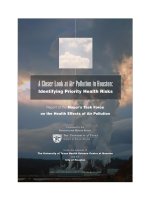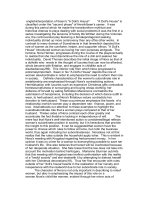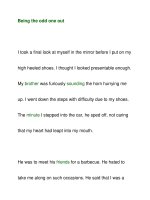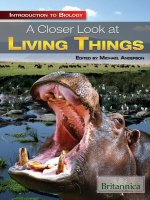a closer look at living things
Bạn đang xem bản rút gọn của tài liệu. Xem và tải ngay bản đầy đủ của tài liệu tại đây (26.47 MB, 89 trang )
Published in 2012 by Britannica Educational Publishing
(a trademark of Encyclopædia Britannica, Inc.)
in association with Rosen Educational Services, LLC
29 East 21st Street, New York, NY 10010.
Copyright © 2012 Encyclopædia Britannica, Inc. Britannica, Encyclopædia Britannica, and the
Thistle logo are registered trademarks of Encyclopædia Britannica, Inc. All rights reserved.
Rosen Educational Services materials copyright © 2012 Rosen Educational Services, LLC.
All rights reserved.
Distributed exclusively by Rosen Educational Services.
For a listing of additional Britannica Educational Publishing titles, call toll free (800) 237-9932.
First Edition
Britannica Educational Publishing
Michael I. Levy: Executive Editor, Encyclopædia Britannica
J.E. Luebering: Director, Core Reference Group, Encyclopædia Britannica
Adam Augustyn: Assistant Manager, Encyclopædia Britannica
Anthony L. Green: Editor, Compton’s by Britannica
Michael Anderson: Senior Editor, Compton’s by Britannica
Sherman Hollar: Associate Editor, Compton’s by Britannica
Marilyn L. Barton: Senior Coordinator, Production Control
Steven Bosco: Director, Editorial Technologies
Lisa S. Braucher: Senior Producer and Data Editor
Yvette Charboneau: Senior Copy Editor
Kathy Nakamura: Manager, Media Acquisition
Rosen Educational Services
Jeanne Nagle: Senior Editor
Nelson Sá: Art Director
Cindy Reiman: Photography Manager
Karen Huang: Photo Researcher
Matthew Cauli: Designer, Cover Design
Introduction by Jeanne Nagle
Library of Congress Cataloging-in-Publication Data
A closer look at living things / edited by Michael Anderson.
p. cm.—(The Environment: Ours to Save)
“In association with Britannica Educational Publishing, Rosen Educational Services.”
Includes bibliographical references and index.
ISBN 978-1-61530-583-4 (eBook)
1. Organisms—Juvenile literature. 2. Life (Biology)—Juvenile literature. I. Anderson, Michael, 1972-
QH309.2.C564 2012
578—dc22
2011011720
On the cover: A hippopotamus, a huge mammal that lives in eastern Africa, is seen against the back-
drop of Ngorongoro Crater, a nature reserve in East Africa. Shutterstock.com
Interior background images Shutterstock.com
C ONTENTS
IntroductIon 6
chapter 1 the characterIstIcs of LIvIng thIngs 10
chapter 2 ceLLs, tIssues, and organs 21
chapter 3 nutrItIon and energy productIon 37
chapter 4 evoLutIon and the hIstory of LIfe on earth 45
chapter 5 the cLassIfIcatIon of LIvIng thIngs 58
c
oncLusIon 75
g
Lossary 76
f
or More InforMatIon 79
B
IBLIography 82
I
ndex 83
t
t
t
he
c
haracter
I
st
c
c
c
s
t
ssues
c
c
c
e
LL
s
,
t
I
tI t
ssues
,
and
n
n
n
e
n
n
n
utr
I
t
I
on
and
e
e
e
e
vo
L
ut
I
on
and
the
e
e
e
vo
L
ut
I
on
and
the
t
t
t
c
ass
cat
t
t
t
he
c
L
ass
I
f
I
cat
I
INTRODUCTION
6
T
he world is filled with living and
nonliving things. In most cases, fig-
uring out which of them are alive is
easy. For instance, it’s obvious that a fuzzy
woodland creature scampering across a field
is alive, while a rock plunked down in the
middle of that same field is not. Science,
however, doesn’t leave such things to casual
observation. In order for an organism to be
alive, it must pass a series of seven tests.
One test concerns movement. Living
things are able to get from one location to
another, or they at least have movement
within themselves. For an example of the
second type of movement, consider a tree.
It can’t move from one place to another,
but it does have the ability to move water,
nutrients, and other materials internally.
Whatever the type of motion, it must occur
under the organism’s own power. Being
pushed, pulled, or otherwise forced to move
doesn’t count.
A second test is sensitivity. Living
organisms respond to conditions in their
environment using whatever senses they
have. Plants stretch and grow toward sun-
light. Animals and people flinch when they
hear a loud sound or feel a sharp touch.
7
The ability to gather nutrients (the source
of energy) from food sources is another test
that proves something is alive. Eating other
organisms is how most animals, including
humans, obtain energy. Plants make their
own food through a chemical process known
as photosynthesis. Some food energy is used
right away, while some is stored for later use.
The process used to create energy from
food is another essential characteristic of
living things. It’s called respiration. In most
cases, respiration involves the exchange of
oxygen and carbon dioxide, a process that
releases energy. Humans and land animals
inhale oxygen and exhale carbon dioxide
from the air using lungs. Fish and many other
aquatic animals don’t have lungs but are able
to absorb oxygen and expel carbon dioxide
through structures called gills. Plants absorb
and push out gases through stomata, or pores,
in their leaves.
Living things grow, meaning new cells are
added on to or replace old cells that make
up an organism’s body. Examples of growth
include legs or stems getting longer, teeth
sprouting through the gums of youngsters,
and new layers of skin or wood that cover and
heal wounds. In a few special cases, plants
8
A Closer look At living things
A C
loser
l
ook
A
t
l
iving
t
hings
thingst
Scientists have discovered nearly 2 million dierent species, or kinds,
of living things. Most of these species are animals. About half of all spe-
cies are the animals known as insects. Encyclopædia Britannica, Inc.
loser
l
ook
A
t
l
iving
t
hings
thingst
Scientists have discovered nearly 2 million dierent species, or kinds,
A Closer look At living things
and animals can replace a body part that has
been lost—a tail, for example—through a
process called regeneration.
A living organism also has to be able to cre-
ate more of its kind through reproduction.
9
introduCtion
Living things reproduce either sexually, with
two parents, or asexually, where an organism
creates new life on its own.
The final test that every living thing must
pass is the ability to get rid of waste and
toxic substances through excretion. These
unwanted and potentially harmful materials
are produced in plants, animals, and humans
in the process of living. Plants release waste
gases into the air through their stomata.
Animals and humans sweep waste and toxins
out of their bodies primarily through sweat,
urine, and feces.
The ability to do just one or a few of the
functions listed here is all well and good, but
that doesn’t mean that something is alive. All
seven characteristics must be present for an
organism to be considered a true living thing.
Chapter 1
10
The Characteristics
of Living Things
L
iving things include many kinds of
organisms, from the plants, ani-
mals, fungi, and algae that can be
readily seen in nature, to the multitude of
tiny creatures known as protozoa, bacte-
ria, and archaea that can be seen only with
a microscope. Living things can be found
in every type of habitat on Earth—on land
and in lakes, rivers, and oceans. Although all
these organisms are very different from one
another, they all have two things in common:
They are descended from a single ancient
ancestor, and they are alive.
Most scientists believe that the first living
organism on Earth probably evolved within
a billion years of Earth’s formation, which
occurred roughly 4.5 billion years ago. This
belief is based on evidence from the fossil
record. Fossil remains of microorganisms
resembling cyanobacteria (a group of micro-
organisms formerly known as blue-green
algae) were discovered embedded in rocks
that were roughly 3.5 billion years old.
the ChArACteristiCs of living things
11
The early Earth was very different from
the Earth of today. The atmosphere was rich
in hydrogen, which was critical to the chemi-
cal events that later took place. According to
one scientific hypothesis, soupy mixtures of
elements important to life, such as carbon,
The colors of Morning Glory Pool, a hot spring in Yellowstone National
Park, are the result of dierent types of cyanobacteria, which are micro-
organisms that thrive in harsh environments. Shutterstock.com
12
A Closer look At living things
nitrogen, oxygen, and hydrogen, were concen-
trated in warm pools bathed in the ultraviolet
rays of the Sun. Out of this mix, chemical
elements combined in reactions that grew
increasingly complex, forming organic mol-
ecules such as proteins and nucleic acids. As
they combined and recombined, these mole-
cules eventually formed a highly primitive cell
capable of reproducing itself. Over millions
of years, the process of natural selection then
aided the evolution of single- and multicelled
organisms from an ancient common ancestor.
There are seven key functions, or pro-
cesses, necessary for life. To be categorized as
a living thing, an organism must be able to do
all of these.
Movement
Living things have the ability to move in
some way without outside help. The move-
ment may consist of the flow of material
within the organism or external movement
of the organism or parts of the organism.
Sensitivity
Living things respond to conditions around
them. For example, green plants grow toward
13
sunshine, certain microorganisms shrink into
tiny balls when something touches them, and
human beings blink when light shines into
their eyes.
Respiration
All living organisms must be capable of
releasing energy stored in food molecules
through a chemical process known as cellular
respiration. In aerobic respiration, oxygen
is taken up and carbon dioxide is given off.
In single-celled organisms, the exchange of
these gases with the environment occurs
across the organism’s cellular membrane.
In multicellular organisms, the exchange of
the gases with the environment is slightly
more complex and usually involves some
type of organ specially adapted for this pur-
pose. Large multicellular animals such as
birds and mammals must breathe in oxygen,
which travels to the lungs and is transferred
to the blood flow of the body’s arteries. The
arterial system carries this fresh oxygen to
all the tissues and cells of the body, where
it is exchanged for carbon dioxide, a cel-
lular waste product that must be carried
back to the lungs so that the organism can
exhale it.
the ChArACteristiCs of living things
14
A Closer look At living things
Insects breathe through holes in the sides of their bodies. Fish and young amphibians
have organs called gills to take in oxygen from water. Mammals, birds, reptiles, and
adult amphibians breathe through lungs. Encyclopædia Britannica, Inc.
15
Plants respire too, but they do it through
openings called stomata, which are found
on the underside of their leaves. Certain
types of bacteria and archaea use a type of
cellular respiration, called anaerobic respi-
ration, in which the role of oxygen is carried
out by other substances. Anaerobic respi-
ration may make use of carbon dioxide or
nitrate, nitrite, or sulfate ions, and it allows
the organism to live in an environment with-
out oxygen.
Nutrition
Living things require energy to survive. The
energy is derived from nutrients, or food.
Green plants, algae, and certain archaea
and bacteria can make food from water and
carbon dioxide via photosynthesis. Plants
called legumes can make proteins by taking
up nitrogen provided by bacteria that live in
nodules in the plant’s roots. Animals, fungi,
protozoa, and many archaea and bacteria
need to get food from an outside source.
They do this in different ways, all of which
depend on what physical adaptations the
organism has. Some animals such as mam-
mals bite into their food with teeth, while
certain insects suck up nectar from flowers.
the ChArACteristiCs of living things
16
A Closer look At living things
A bear gnaws on the bones of an animal it has killed and consumed.
© www.istockphoto.com/Len Tillim
17
Many species of protozoa and bacteria take
in nutrients through membranes that cover
their bodies.
Regardless of how the nutrients are
obtained—or, in the case of autotrophic
organisms, manufactured—the organism’s
physical state will determine how the nutri-
ents are used. Some of the nutrients may be
used for structural repairs—that is, turned
into living material, such as bones, teeth,
scales, or wood. Some portion of nutrients
may be used to provide energy, which the
organism needs in order to function. This
can be compared to the process in which an
engine burns oil or coal and gets energy to
move a train. But note that an engine does
not use coal or oil to make itself larger or
mend parts, as living things do with food.
Growth
Snowballs will grow in size when they are
rolled through snow and salt crystals will
grow in salty water as it evaporates. Although
these lifeless objects become larger, they
do not grow in the way that living things
do. Living things grow by making new parts
and materials and changing old ones. This
the ChArACteristiCs of living things
18
A Closer look At living things
Regeneration
The process by which plants and animals
replace lost or damaged parts by growing
them anew is called regeneration. Often the
growth is abnormal in appearance but com-
pletely functional. A tree trunk that is burned
will produce a new covering for the vital vas-
cular strands that transport water and food,
though the bark may be scarred. A deep cut
on human skin will eventually close with new
skin growth, leaving a scar.
Some animals possess the ability to com-
pletely regenerate a missing part. Lizards can
regenerate a new tail, and salamanders can
replace a limb or even an eye. In humans the
liver can regenerate after partial destruction.
To some extent plants form new meristem
(growth) tissues and produce new shoots after
the tops are pruned.
happens when a seed grows into a plant or a
chick matures into a hen. As human beings
grow, they add new structures, such as teeth,
and change the proportions of others.
A special kind of growth heals injuries.
Shrubs and trees mend injuries by covering
them with bark and adding new layers of
wood. Crabs grow new legs when old ones
19
are lost. Human beings can heal cut skin and
mend broken bones.
Reproduction
When living things
reproduce, they make
new living things. This
is true even of the sim-
plest microorganisms,
which may reproduce by
simply dividing into two
parts. Each new part is
able to move, feed, grow,
and perform the other
functions of living. This
type of reproduction is
called asexual, because it
can be performed with-
out a mating partner.
There are other forms of
the ChArACteristiCs of living things
Some species of whiptail
lizards are able to repro-
duce asexually. Females
lay eggs that have not been
fertilized by a male but still
produce normal young. ©
www.istockphoto.com/
Nancy Nehring
20
A Closer look At living things
asexual reproduction, in addition to sexual
reproduction, which requires a partner.
Asexual reproduction is most commonly
found among the so-called lower organisms,
such as bacteria and some types of proto-
zoa and fungi. They are called “lower” not
because they are unimportant or simple, but
rather because they evolved earlier than the
complex “higher” organisms, such as ver-
tebrates. Mammals and birds, for example,
require a partner to reproduce. Some higher
organisms, however, are able to reproduce
asexually. Certain plants are an example of
this, as are some reptiles.
Excretion
All living organisms create waste prod-
ucts via the processes of living. Much waste
comes from food. The rest is produced by
movement, growth, and other functions of
living. If this waste remained in living things,
it would soon cause illness and death. Thus
living things must have a way to dispose of
waste matter. The process that removes waste
products from the body is called excretion.
C
ells are the building blocks of the liv-
ing world. Living things as diverse as
bacteria, archaea, algae, fungi, proto-
zoans, animals, and plants all consist of one
or more cells, which are made up of compo-
nents that help living organisms eat, respire,
excrete wastes, and perform all of the neces-
sary functions of life. The components are
organized, which means that they fit and
work together. For this reason, living things
are called organisms. Similar cells that work
together form structures called tissues, and
groups of tissues form organs.
Eukaryotes, Prokaryotes,
and Viruses
The activities of the cells are controlled by
the cell’s genetic material—its DNA. In
some types of organisms, called eukaryotes,
the DNA is contained within a membrane-
bound structure called the nucleus. The term
eukaryote derives from the Greek eu (true)
and karyon (nucleus.) In eukaryotic cells,
most specialized tasks, such as obtaining
Chapter 2
Cells, Tissues, and Organs
21
22
A Closer look At living things
Cutaway drawing of a eukaryotic cell. Encyclopædia Britannica, Inc.
energy from food molecules and produc-
ing material for cell growth, occur within a
number of enclosed bodies called organelles.
Many microorganisms, namely bacteria and
archaea, consist of a single cell lacking this
23
complex structure, and their DNA is not
contained in a distinct nucleus. These organ-
isms are called prokaryotes, from the Greek
pro (before) and karyon.
Prokaryotic organisms are believed to
have evolved before eukaryotes. Prokaryotic
organisms such as the cyanobacteria can
photosynthesize food; their food-making
chlorophyll is scattered through the cell. In
eukaryotic photosynthesizing organisms,
such as plants and algae, the chlorophyll is
contained within chloroplasts. Most bacte-
ria have neither nuclei nor chloroplasts and
are heterotrophic, meaning they must obtain
their food from other organisms.
Scientists once believed that prokary-
otic organisms were the simplest organisms.
Then viruses were discovered. A virus is a
very small infective particle composed of
a nucleic acid core and a protein capsule.
Viruses are responsible for many diseases
of plants and animals, and some even infect
bacteria and archaea. A virus is not a cell
itself, but it requires a cell of a living organ-
ism to reproduce, or replicate. The nucleic
acid inside the viral capsule carries the
genetic information that is essential for rep-
lication of the virus. However, this is not
enough for replication to take place. The
Cells, tissues, And orgAns
24
A Closer look At living things
virus also requires the chemical building
blocks and energy contained in living cells in
order to reproduce. When a virus is not in a
living cell it cannot replicate, though it may
remain viable for some time. Scientists still
do not agree that viruses are actually living
things, since these entities cannot sustain
life on their own.
Life in a Single-
Celled Organism
There are many kinds of single-celled organ-
isms that are not prokaryotes. Some of these
single-celled eukaryotes look like slippers,
vases, or balls. Some even have more than one
nucleus. Many swim by waving a flagellum, a
lashlike structure that looks like a thin arm
or tail. Others use hairlike structures, which
are called cilia. One kind has a mouth and a
ring of moving “hairs” that bring in food. It
also has a stalk that can stretch or coil up and
pull the cell away from danger.
A well-known example of a single-celled
eukaryote is the amoeba, a protozoan that
lives in freshwater ponds. To the unaided eye
it looks like a milky speck, but a microscope
shows that the protozoan’s “body” is com-
posed largely of a jellylike substance called









